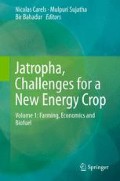Abstract
Microbes play very vital role in the nutrient acquisition to the plants, particularly phosphorus which act as limiting factor for plant growth. The efficiency of microbial flora which includes Azospirillum, Pseudomonas collected from different places was analyzed in phosphate solubilization and nutrient uptake in Jatropha curcas. Besides, VAM population was also studied in all the samples. Potential of these microbes were investigated in field and nursery trials and significant results were observed. Plant microbe interaction was studied thoroughly by several methods using biofertilizers and other phosphate solubilizers (mycoflora). Effect of root exudates on AM fungi colonization was also studied by standard root staining techniques. Positive interaction amongst the flora was recorded in terms of total phosphate solubilization or the enzymes released, total leaf phosphorus content and proteins through SDS-PAGE and spectrophotometric analysis. The small subunit rRNA gene (rDNA) specific for AM fungi was amplified with taxon specific primers (VANS I) paired with universal primer (NS2). Variation in colonized and non colonized PCR product was detected. Colonized roots depicted a 550 bp amplification which was not detected in the uninoculated plant. Results could also be obtained from roots showing 30 % colonization. Root exudates enhanced the population by 80 % while other treatments showed less colonization. Growth, collar diameter, leaf phosphorus and protein content of all the treated plants had a significant variation. Single super phosphate enhanced the growth at the most followed by VAM. Impact of plant microbe interaction on growth and development of J. curcas was also evaluated and maximum effect was recorded from treatment containing mixed culture. Remarkable increase was observed in all the parameters evaluated. The experiment laid out during August 2009, with microbial inoculants significantly enhanced the growth and collar diameter of J. curcas plants as compared with untreated (control) plants.
Access this chapter
Tax calculation will be finalised at checkout
Purchases are for personal use only
References
Fitter AH, Garbye J (1994) Interaction between mycorrhizal fungi and other soil organisms. Plant Soil 159:123–132
Ho I, Zak B (1979) Acid phosphatase activity of six ectomycorrhizal fungi. Can J Bot 79:1203–1205
Jackson ML (1973) Soil Chemical Analysis. Prentice Hall of India, New Delhi
Liang SF (1994) Function and application of dissolving phosphorus microbial fertilizer. Soil Fertil 2:46–48
Linderman RG (1988) Mycorrhizal interactions with the rhizosphere microflora: the mycorrhizosphere effect. Phytopathology 78:366–371
Lowry OH, Rosebrough NJ, Farr AL (1952) Protein measuring with folin phenol regent. J Biol Chem 193:265–275
Mc Claugherty CA, Linkins AE (1990) Temperature response of enzymes in two forest soils. Soil Biol Biochem 22:29–33
Safir GR (1994) Involvement of cropping systems plants produced compounds and inoculum production in the functioning of VAM fungi. In: Pfilger FL, Lindermann RG (eds) Mycorrhiza and plant health, 9th ed. APS Press, St. Paul
Singh AK, Jamaluddin (2008) Phosphatase activity in the rhizosphere of medicinal plants inoculated with arbuscular mycorrhizal fungi. Mycorrhiza News;19:11–12
Tabatbai MA, Bremner JM (1969) Use of P-nitrophenol phosphate for assay of soil phosphatase activity. Soil Biol Biochem 1:301–307
Waksman SA (1922) A method of counting the number of fungi in the soil. J Bacteriol 7:339–341
Warcup JH (1952) Soil plate method for isolation of fungi from soil. Nature 166:117–118
Author information
Authors and Affiliations
Corresponding author
Editor information
Editors and Affiliations
Rights and permissions
Copyright information
© 2012 Springer Science+Business Media New York
About this chapter
Cite this chapter
Jamaluddin (2012). Role of Microbial Inoculants on Growth and Development of Jatropha curcas L.. In: Carels, N., Sujatha, M., Bahadur, B. (eds) Jatropha, Challenges for a New Energy Crop. Springer, New York, NY. https://doi.org/10.1007/978-1-4614-4806-8_8
Download citation
DOI: https://doi.org/10.1007/978-1-4614-4806-8_8
Published:
Publisher Name: Springer, New York, NY
Print ISBN: 978-1-4614-4805-1
Online ISBN: 978-1-4614-4806-8
eBook Packages: Biomedical and Life SciencesBiomedical and Life Sciences (R0)

